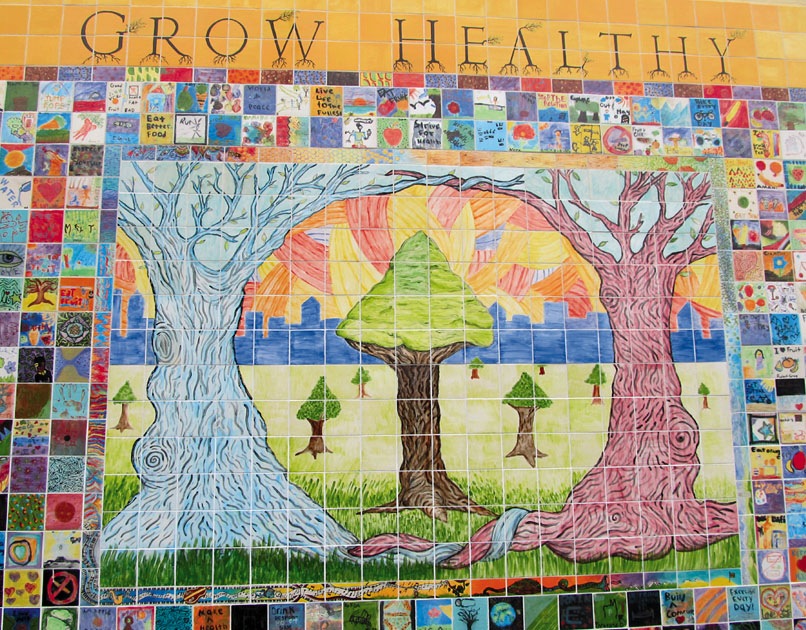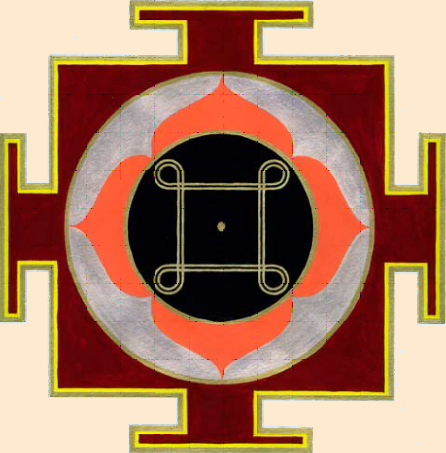The Nonviolence of Health & Healing: The Satyagraha Foundation Interview with Dr. Richard Hoofs

“Grow Healthy,” South Berkeley California mural;
by Youth Spirit Artworks; photo by Ariel Messman-Rucker;
courtesy of Street Spirit.
Satyagraha Foundation (SF): In your book, Prescription for Self-Healing (“Zelfgenezing op doktersrecept”) you refer to the ancient Greek, Hippocratic origins of western medicine and the principle, that “the action of healing must avoid harm.” The Gandhian term for nonviolence, ahimsa, can be translated as, “Do no harm”. Can we also speak of ahimsa as a principle for healing?
Richard Hoofs (HOOFS): Absolutely we can apply ahimsa to healing. The first principle for a doctor or health practitioner is not to harm the patient. Every doctor swears an oath to this. The word heal, in fact, comes from the root to make whole, or to become one again, and by this I mean to reconnect with the source, to the light within. To reconnect with this source and light within is a sacred event. It is healing.
SF: Can you describe more precisely “this source and light within” and how reconnecting might lead to healing and health?
HOOFS: The Source within is our Soul, which is part of the great Soul and is everywhere. This great Soul we also know as the Creator, the Light, God, Brahman, or Allah. If you stay connected with your real Self, you are connected with the Divine.
Healing, becoming whole, is to reconnect with the Divine. The Buddhists have the saying that everyone must follow his own Dharma, his one true path. If you stay connected with your true Self, you are following your Dharma.
SF: Gandhi spoke of oneness as “the logical foundation of the active practice of nonviolence (that is, as the foundation of satyagraha)”, as Kathryn Tiddick and other of his interpreters have pointed out. Can you describe some practical ways in which oneness, or reconnecting to the source, the light, contributes to our healing and to our health?
HOOFS: Reconnecting to the source, to oneness, steadies our heart, which reduces blood pressure by bringing our heart rhythm into balance. It lights up our life, healing depressive feelings and anxieties. It brings our muscles into balance: not too tight and not too loose. It gives our voice a balanced, divine sound: not too strong and not too weak. Reconnecting literally enlightens us, so that through our eyes the world becomes brighter, becomes shining.
SF: What methods would you recommend we cultivate in order to reconnect to the source, and how would each contribute to our health?
HOOFS: There are a number of things we can do to cultivate reconnecting, and contribute to our health. I don’t mean to be exhaustive, but I can mention some of the following.
Meditation:
This helps to stabilize our heart rhythm and reduce our blood pressure; it optimizes respiration and balances our muscles; it deepens our sleep or diminishes sleeplessness, revitalizing our bodies; it lessens depressive feelings. These are only some of the effects for which there is good scientific evidence and research. I’d add that most of all meditation gives us the chance to reconnect with the light in ourself, to reconnect with our Self, making it possible for us to be in touch with and become who we are.
Yoga and tai chi:
These body postures and movements allow for the proper flow of energy. They reconnect us with our vehicle, our temple on earth: our body.
Chakra and aura yoga:
Both of these help us reconnect with the energy centers and energy in the Self. By balancing our energy we can bring back the balance in our body. They help prevent the development of disease, both physical and mental, and also help actively cure complaints and diseases.
“Yantra of Harmony;”
courtesy of Sarah Noordhoek
Yantra painting:
This is a very old, meditative painting technique. It also helps us reconnect with the Self’s energy centers. It helps us, that is, reconnect with our True Self.
Chanting:
The singing of a divine mantra helps us to reconnect with our true voice. It rebalances our respiration system and clears our throat.
Listening, singing, playing an instrument: music from or to the heart:
To listen to or make music which comes from the heart enlightens our heart and reconnects us with others.
To walk in and enjoy nature:
We reconnect with mother earth and strengthen our connection with the physical world around us, and our own body.
SF: In your book, Prescription for Self-Healing you say that the body “never lies”, and that it sends us signals. Could you clarify what you mean by “never lies”? And what are these signals? How can we recognize them, and what actions can we take to respond to the signals?
The body always tells us the truth; it can never pretend.
HOOFS: The body always tells us the truth; it can never pretend. We can deny that we are feeling pain or sadness; we can make a forced smile, but the body simply cannot pretend. It will respond to the pain it is suffering by reacting to it, for example, by a painful feeling in the chest.
The signals from our body are direct. They tell us directly what is going on. A weak feeling in our calves or feet tells us that we are unsteady on our feet and unsure about ourselves.
In order to listen to the truth of our body we need to connect with our body. We need to connect with the material world of our body and of the earth. It has to do with really being at the place where you are at that moment; with being in your body. It has to do with the first chakra at the base of the spine, which rules our physical energy. If there is balance in the first chakra you can fully connect with your body and listen to the signals it is giving you.
SF: In the morning newspaper the other day there was a story about contaminated salmon. Hundreds of people were stricken with salmonella. The story also said that some of the people stricken were angry, at the company and at the store for selling it. In other words, illness can come from without and within, and it can cause not only physical symptoms but emotional. What is the best way to heal the physical and emotional when we become ill? What methods are the most holistic?
HOOFS: Holistic medicine can be understood as simply saying that a human being is not just the physical body, but also has a soul, a Self, and that these two are strongly interconnected.
We can also say that the physical and emotional are strongly interconnected. In acupuncture, for example, blocked emotions are considered one of the main reasons why people develop an illness. When the energy flows properly again, the energy heals the patient. In order to let the energy flow again, it’s necessary to connect with it.
It is important to see our emotions as they really are,
as packages of energy, which give us the chance to change.
Connecting with our energy is an important way to stay in touch with our body and emotions. It’s important not to block our emotions or be driven away by them, but also important not to identify completely with them. It is important to see our emotions as they really are, as packages of energy, which give us the chance to change.
SF: If the body and the emotions are interconnected, do emotions also always tell us the truth? Can emotions pretend? What “truths” do emotions tell us? As packages of energy how do emotions help us change?
HOOFS: Pure emotions are certainly real; they send us a message from our inner world as a reaction to the outer world. The message is the first step to change, a change that is in our inner life and in our outer reactions. Sadness brings sorrow and self-comforting; anger bears the power to react; happiness brings us enthusiasm and joy; fear instills the energy to make things safer in and outside ourselves.
SF: We have a saying in English, “An ounce of prevention is worth a pound of cure.” How can we utilize the truth the body and emotions tell us to prevent illness?
HOOFS: It’s very simple. We just have to listen in a direct way. If you have pain, it’s a sign that you need to rest and slow down. If your heart is restless, you need to calm down and make it feel safer. If you are sad, listen to this sadness and take time to heal your wounds, both inner and outer. Do not pretend you are happy and walk around with a forced smile. So, listen to your own signs; calm down; slow down, and take care of yourself. It’s simple.
SF: Sometimes it seems that despite our best efforts we become ill. We go to a film with friends, and the next day we come down with the flu. We ride the trams and people cough on us; we get a sore throat. More serious ailments can afflict us and we learn that we had a “genetic disposition”. When we become ill, or are diagnosed with a serious illness, can you summarize some first steps we can take towards healing, for both large and small ailments?
HOOFS: I would say take time to rest; take time to sleep; take time to meditate; take time to eat and drink well. It is very important to be open with yourself, to accept yourself, and love yourself.
SF: Very often too our friends and loved ones are sick. Sometimes it is just flu, but sometimes it is more serious. Those we hold dear suffer heart attacks, contract cancer, or debilitating diseases. What attitude should we have towards them? Can we act as healers for those we love?
HOOFS: Isn’t the answer the same? Love others and be open with them. For certain, this has a healing effect.
SF: Are there final thoughts concerning health and nonviolence that you might convey to our readers?
HOOFS: Health and nonviolence have a very strong connection with each other. Being at peace, being nonviolent is the best means to preserve an optimal state of health. Most of all it is important to stay open to yourself and the world, to love yourself and accept yourself. Let who you are become the best friend of your soul.
EDITOR’S NOTE: Dr. Richard Hoofs is a General Practitioner (GP) in Schoorl, Netherlands. He is also one of the leading Dutch practitioners of alternative medicine, a past member of the Alternative Medicine Group, Amsterdam, and a spiritual healer, coach, and licensed acupuncturist. He is the author of countless essays. His books Zelfgenezing op doktersrecept (Prescription for Self-Healing), Cirkel van Leven (Circle of Life), and more recently Een nieuwe wereld binnen je bereik (A New World within your Grasp) have won considerable acclaim. He maintains an active Dutch language website where there is information about his books and further biographical details. The interview was conducted in English by email October-November 2012.
Joseph Geraci is the director of the Satyagraha Foundation and editor of our website.





